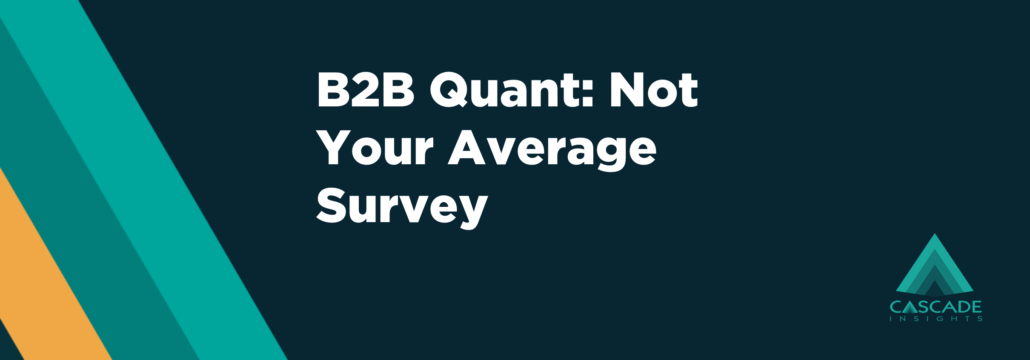B2B quantitative research works differently than in B2C.
Consider Greg, a 48-year-old male who loves baseball, likes Italian food, and has two kids. Greg will eventually turn into a 49-year-old male who loves baseball a little more, likes Italian food a little less, and still has two kids – albeit slightly older.
A B2C firm building a sample on personas like Greg have it easy. People’s preferences only change so much.
In the B2B world, 48-year-old Greg might lead data center initiatives for Microsoft. However, at 49, Greg might become the CEO of a tech startup.
As a result, Greg might be a great fit for one B2B quant study at the age of 48, but just one year later might not fit the same study at all. Depending on the study, Greg’s title, company, areas of responsibility, service experience, etc. may make him a great candidate, or disqualify him completely.
No B2B panel firm can track these types of granular details with consistency. To further complicate matters, B2B populations are tougher to reach than those in B2C. This makes it nearly impossible to keep any B2B panel up to date with all the relevant details. As a result, a B2C approach to quantitative research doesn’t work in B2B.
However, by specializing in B2B market research, we’ve learned a few key skills to do B2B quantitative studies well.
Right People: We’re Good at Weeding Out Bad Respondents
As B2B is a niche field, sample sizes are destined to be small. B2B solutions may have a total market of less than 10,000 organizations. This is a far cry from the number of potential customers a B2C product might serve, which can be tens of millions of individuals.
Because sample sizes are so small, not every B2B question can be answered with quant. Nevertheless, for the questions where a quant survey is possible, it is imperative to obtain good respondents.
Remember Greg? His experience may make him a great recruit for a survey.
Unfortunately, in survey world, there are lots of pretenders. Joe is a college student who has signed up to be a professional survey taker to make a little extra cash. Bob is a robot survey respondent. Ivan lives in Siberia and lied about his credentials to get on a third-party survey list, again to make a little money.
Joe, Bob, and Ivan might provide helpful answers in a B2C quant survey, but simply don’t have the expertise and experience to provide real insight in a B2B quant study. As a result, their responses could give you misleading answers to your questions.
It’s important to achieve a mathematically responsible quant survey. While statistical significance is a function of sample size, achieving a sample size of 400 doesn’t mean anything if as many as 250 of those responses are Joes, Bobs, and Ivans.
Instead, it’s better to get 250 Gregs: people well-qualified to provide real insight.
But remember, 48-year-old Microsoft Greg might provide very different insights from 49-year-old startup CEO Greg. Consequently, we’ve arrived at one of the most difficult parts of B2B market research: recruiting.
Our long familiarity with B2B personas helps us recruit precisely the right people. We also know how to identify and stay away from bad survey lists, where robots might be giving answers. Ultimately, you can have confidence that exactly the right people have given you valuable insights.
Right Questions: Use Qual to Inform Quant
B2B quantitative surveys are great for measuring or validating. Some good questions for quantitative research are:
- How satisfied are my customers?
- Which competitors are my customers aware of?
- Which products are buyers using?
- What buying criteria is more or less important?
- Where does my brand rank compared to those of competitors?
What B2B quantitative research is bad at on its own is answering “why.” As in, why aren’t my customers satisfied? What made them choose this particular product? And so on.
B2B quantitative research can also fail if you don’t know what you’re measuring. For example, you might be trying to measure awareness with the wrong audience or testing messaging on a channel your buyers don’t visit.
Fortunately, the insights obtained from qualitative in-depth interviews can provide key background knowledge for an effective quantitative study.
For example, a qualitative study might provide extremely precise language for a quantitative study, or help the survey speak in the buyers’ language. Both are critical in B2B tech research.
B2B Quantitative Research Works… When Done Precisely.
When you’re about to make a really important decision, good quantitative research can boost your confidence in making the right choice.
It’s hard to have confidence in a survey that bots responded to. It’s also hard to derive insights from incomplete survey responses because the questions are uninformed.
At the end of the day, good B2B quantitative research boils down to this: knowing precisely who to ask questions of, and what questions to ask them.
This article is brought to you by Cascade Insights. With B2B focused market research and marketing services, Cascade Insights helps companies seize opportunities in the B2B technology sector.
For advising on this article, special thanks to CEO Sean Campbell, President & CTO Scott Swigart, Director of Systems Designs Philippe Boutros, and Research Analyst Alissa Ehlers.

